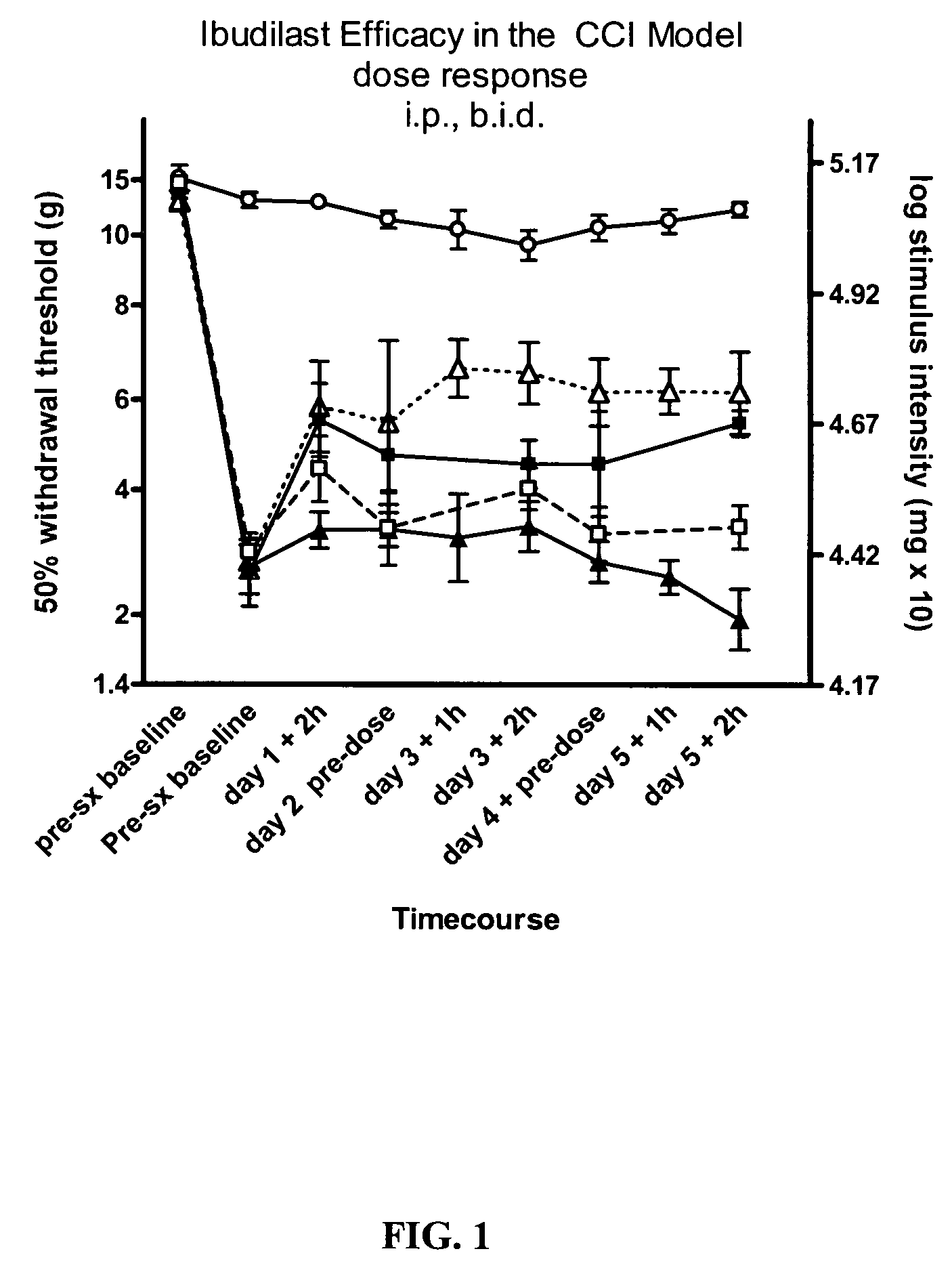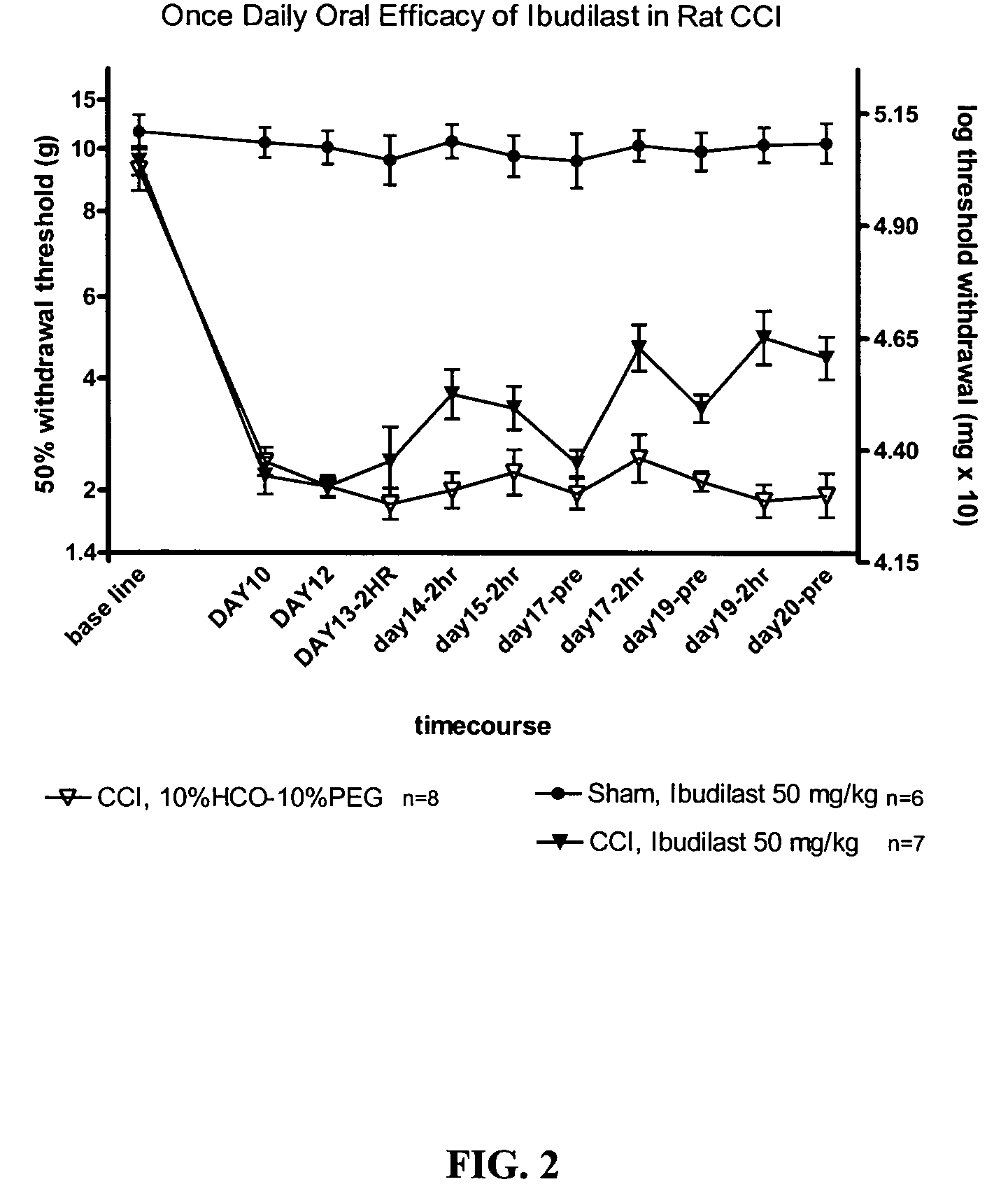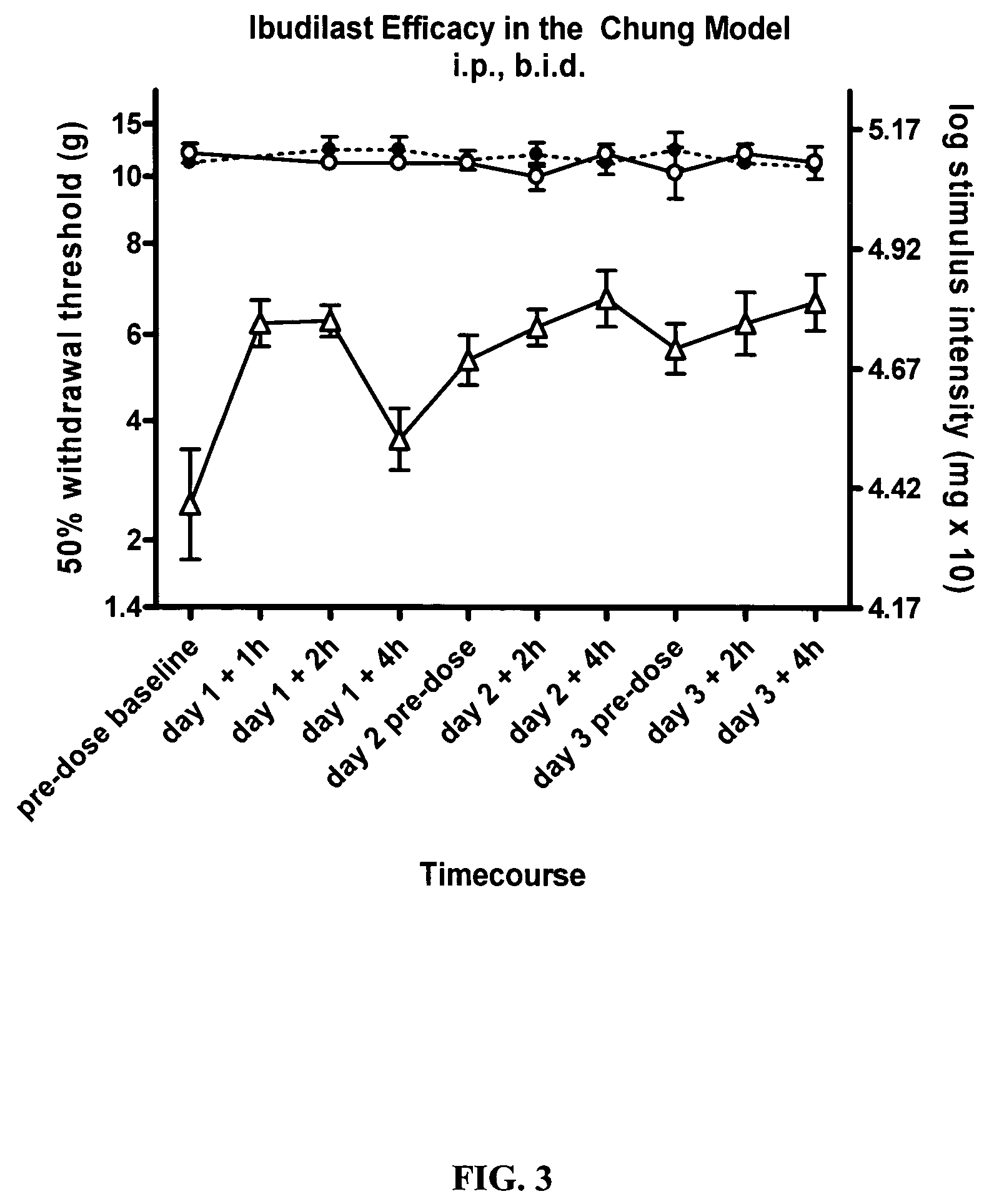Method for treating neuropathic pain and associated syndromes
a neuropathic pain and associated syndrome technology, applied in the field of neuropathic pain treatment methods, can solve the problems of ineffective neuropathic pain management, inability to treat chronic pain, and inability to meet the needs of patients, and few, if any, ethical drugs have been prospectively developed for the treatment of chronic pain
- Summary
- Abstract
- Description
- Claims
- Application Information
AI Technical Summary
Benefits of technology
Problems solved by technology
Method used
Image
Examples
example 1
Effect of Ibudilast on Mechanical Allodynia in a Rat CCI Model of Neuropathic Pain
[0149]The effect of ibudilast on mechanical allodynia was assessed in a rat chronic constriction injury (CCI) model of neuropathic pain.
Methods.
[0150]Test Agents: Ibudilast was obtained as pure powder from Sigma (St. Louis, Mo.) or Haorui Pharma (Edison, N.J.). It was prepared daily as a solution for intraperitoneal (i.p.) administration. An appropriate amount of ibudilast was dissolved in 100% polyethylene glycol (PEG) 400 (Sigma) and then diluted down to a final concentration of 35% PEG400 in sterile saline (0.9% for injection).
[0151]Test Article Administration: Ibudilast was administered at 2.5 mg / kg (0.9 ml / kg of 2.8 mg / ml in 35% PEG / saline), 7.5 mg / kg (2.7 ml / kg of 2.8 mg / ml in 35% PEG / saline), or 10 mg / kg twice daily, (3.7 ml / kg of 2.7 mg / ml in 35% PEG / saline) each morning (typically 8 am) and pm (typically 3 pm). For oral efficacy studies, ibudilast was administered at 50 mg / kg formulated in a s...
example 2
Effect of Ibudilast on Mechanical Allodynia in a Rat Chung Model of Neuropathic Pain
[0167]The effect of ibudilast on mechanical allodynia in a rat Chung model of neuropathic pain was assessed.
Methods
[0168]Test Agents: Haorui and Sigma ibudilast was formulated as described above. Ibudilast was administered at 10 mg / kg twice daily, (3.7 ml / kg of 2.7 mg / ml in 35% PEG / saline) i.p. each morning (typically 8 am) and pm (typically 3 pm).
[0169]Animals: Pathogen-free adult male Wistar rats (150-200 g; Elevage Janvier) were used in all experiments. Rats were housed in temperature (23+ / −3° C.) and light (12:12 light: dark; lights on at 0700 hr) controlled rooms with standard rodent chow and water available ad libitum. Behavioral testing was performed during the light cycle.
[0170]Chung model: Rats were anesthetized under isoflurane (4-5% induction and 2-3% maintenance in 100% oxygen) and an incision at the L4-S2 levels was performed to expose the left L5 and L6 spinal nerves. A ligature was tie...
example 3
Effect of Ibudilast on Mechanical Allodynia in a Rat Model of Taxol-Induced Neuropathic Pain
[0175]The effect of ibudilast on mechanical allodynia in a rat model of taxol-induced neuropathic pain was assessed as described below.
Methods
[0176]Test Agents: Ibudilast was formulated as described above. Ibudilast was administered at 7.5 mg / kg (2.7 ml / kg of 2.8 mg / ml in 35% PEG / saline i.p. each morning (typically 8 am) and pm (typically 3 pm).
[0177]Animals: Pathogen-free adult male Sprague-Dawley rats (280-350 g; Harlan Labs) were used in all experiments. Rats were housed in temperature (23+ / −3° C.) and light (12:12 light: dark; lights on at 0700 hr) controlled rooms with standard rodent chow and water available ad libitum. Behavioral testing was performed during the light cycle.
[0178]Taxol Model: Neuropathic pain was induced by administration of 4 i.p. injections on alternate days (Day 0, 2, 4, and 6) of 1 mg / kg taxol (Paclitaxel®, cumulative dose 4 mg / kg). Neuropathic pain onset was maxim...
PUM
| Property | Measurement | Unit |
|---|---|---|
| time | aaaaa | aaaaa |
| time | aaaaa | aaaaa |
| concentration | aaaaa | aaaaa |
Abstract
Description
Claims
Application Information
 Login to View More
Login to View More - R&D
- Intellectual Property
- Life Sciences
- Materials
- Tech Scout
- Unparalleled Data Quality
- Higher Quality Content
- 60% Fewer Hallucinations
Browse by: Latest US Patents, China's latest patents, Technical Efficacy Thesaurus, Application Domain, Technology Topic, Popular Technical Reports.
© 2025 PatSnap. All rights reserved.Legal|Privacy policy|Modern Slavery Act Transparency Statement|Sitemap|About US| Contact US: help@patsnap.com



